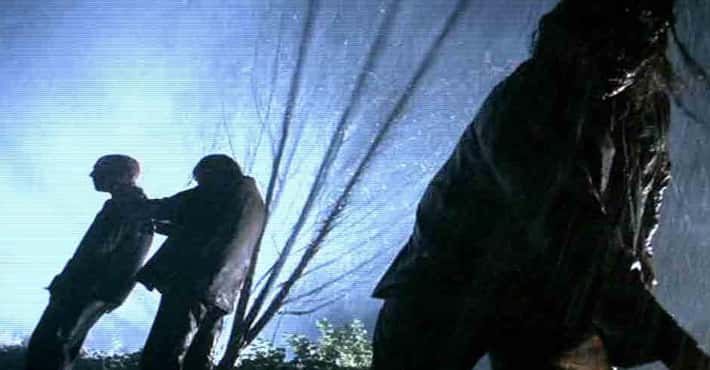23 X-Files Storylines That Were Based on Real Life Stories
"Humbug" (Season Two, Episode 20)
Video: YouTube Many decades ago, freak shows were common across the United States as part of traveling carnivals and circuses. One show in particular, called "The Jim Rose Circus," stood out amongst the rest. The episode "Humbug" was inspired by a VHS tape of The Jim Rose Circus. In fact, you can watch some of the freak show members act as characters in the episode, which follows the life of a traveling carnival.
Many decades ago, freak shows were common across the United States as part of traveling carnivals and circuses. One show in particular, called "The Jim Rose Circus," stood out amongst the rest. The episode "Humbug" was inspired by a VHS tape of The Jim Rose Circus. In fact, you can watch some of the freak show members act as characters in the episode, which follows the life of a traveling carnival."The Erlenmeyer Flask" (Season One, Episode 24)
Video: YouTube Some say it was mass hysteria, others claim it was the ingestion of a powerful solvent. One thing everyone agrees on is that on February 19, 1994, a woman named Gloria Ramirez checked into an emergency room in Riverside, CA. The smell of her blood incapacitated 23 staff members, five of which had to be hospitalized themselves. Gloria died within 45 minutes of her arrival, but the mystery of her toxic blood continues to linger. This incident was the inspiration behind The X-Files Season 1 episode, "The Erlenmeyer Flask."
Some say it was mass hysteria, others claim it was the ingestion of a powerful solvent. One thing everyone agrees on is that on February 19, 1994, a woman named Gloria Ramirez checked into an emergency room in Riverside, CA. The smell of her blood incapacitated 23 staff members, five of which had to be hospitalized themselves. Gloria died within 45 minutes of her arrival, but the mystery of her toxic blood continues to linger. This incident was the inspiration behind The X-Files Season 1 episode, "The Erlenmeyer Flask.""The Jersey Devil" (Season One, Episode 5)
Video: YouTube
New Jersey - home to the Jersey Shore "guido" and The Jersey Devil sightings. In January 1909, hundreds of people reported that a kangaroo-like animal with leathery bat wings and an elongated horse face attacked trolley cars, social clubs, and hunters around town. Police even claimed to have spotted and fired upon the monster, but despite their best efforts to hunt it down, a body was never found.
The X-Files riffs on the legend of the Jersey Devil in the episode, "The Jersey Devil" (naturally). It focuses on the resurgence of attacks on the New Jersey Turnpike that leave victims with missing their limbs."Død Kalm" (Season Two, Episode 19)
Video: YouTube
The Philadelphia Experiment was an eerie real life examination that has served as inspiration for countless sci-fi and horror TV shows since its occurrence in October 1943. The X-Files episode "Død Kalm" not only uses the original story as insight, it also drops several hints and references throughout.
"Shapes" (Season One, Episode 19)
Video: YouTube The murder mystery of a Native American man spirals into a case about shape-shifting beasts that appear every eight years, and leave nothing but a trace of human remains and mysterious track prints in the snow. All of these ideas were borrowed from the Native American myths of the Wendigo, and "fleshed out" in the episode "Shapes."
The murder mystery of a Native American man spirals into a case about shape-shifting beasts that appear every eight years, and leave nothing but a trace of human remains and mysterious track prints in the snow. All of these ideas were borrowed from the Native American myths of the Wendigo, and "fleshed out" in the episode "Shapes.""Home" (Season Four, Episode 2)
Video: YouTube
The episode "Home" is based on the true story of the Ward Family, made up of four illiterate brothers who lived under one roof outside Syracuse, NY. When one of them was found dead, a murder investigation opened by the police prompted rumors of mercy killings, and interfamilial relations gone bad.
One brother was put on trial for allegedly taking his siblng's life, but was eventually acquitted. In the end, a slayer was never officially named, leaving the case something of a mystery. Still, the story was fascinating enough to spawn an unnerving documentary, which you can read more about here.
This story, along with a tale told by Charlie Chaplin in his autobiography, formed the basis for this spine-chilling episode.
"Irresistible" (Season Two, Episode 13)
Video: YouTube Serial killer and necrophiliac Jeffrey Dahmer claimed that during his murders, he actually shape-shifted into a demonic being.Though there is hardly any credible sourcing to back up Dahmer's statement, it is certainly curious to those who hear the tale. The Dahmer case inspired the episode "Irresistible."
Serial killer and necrophiliac Jeffrey Dahmer claimed that during his murders, he actually shape-shifted into a demonic being.Though there is hardly any credible sourcing to back up Dahmer's statement, it is certainly curious to those who hear the tale. The Dahmer case inspired the episode "Irresistible.""731" (Season Three, Episode 10)
Video: YouTube
During World War II, the Japanese Imperial army had a special unit called, "Unit 731." You've probably never heard of it because the U.S. and the U.N. agreed to dismiss it if the Japanese surrendered any and all documentation and test results. Unit 731 could be best described as a terrifying testing lab on, and for, humans.
This was the basis for the episode titled, "731." The overall concept of horrific human experimentation is echoed throughout."Duane Barry" (Season Two, Episode 5)
Video: YouTube
In 1848, an explosion during a mining accident sent a crowbar into the head of Phineas Gage, who lived to tell the story. From that day on, Gage was a changed man. He still looked the same once his wounds healed, but his personality was irreparably altered, according to friends and family. The once energetic worker was "no longer Gage." In fact, he was now described as "profane, coarse, and vulgar to decent people."
This fascinating case of head injury similar to that of Dr. Jekyll and Mr. Hyde, inspired The X-Files episode "Duane Barry," which showcases a man who after surviving a bullet to the head, deals with a personality change.
"Folie à Deux" (Season Five, Episode 19)
Video: YouTube Folie à deux is a very particular form of madness in which a person develops a delusional belief or hallucination, and then spreads that delusion to another person. Tackling mental disorders was nothing new for The X-Files, but this time, in the episode "Folie à Deux," agent Mulder himself develops same psychosis as one of the suspects he's investigating.
Folie à deux is a very particular form of madness in which a person develops a delusional belief or hallucination, and then spreads that delusion to another person. Tackling mental disorders was nothing new for The X-Files, but this time, in the episode "Folie à Deux," agent Mulder himself develops same psychosis as one of the suspects he's investigating."El Mundo Gira" (Season Four, Episode 11)
Video: YouTube Latin American folklore tells of a goat killing, blood drinking, reptilian beast from hell, called "El Chupacabra." The tales, appearance, and behavior of the mythical beast were the backbone of the episode "El Mundo Gira," which targets a mysterious fungus that infests a group of refugees.
Latin American folklore tells of a goat killing, blood drinking, reptilian beast from hell, called "El Chupacabra." The tales, appearance, and behavior of the mythical beast were the backbone of the episode "El Mundo Gira," which targets a mysterious fungus that infests a group of refugees."Blood" (Season Two, Episode 3)
Video: YouTube What do you get when you combine chemical insecticides, mass shootings, a crippling fear of blood, and the inhumanity of modern technology? Well, if you're the X-Files writers, you wind up with the episode "Blood," a story loosely based on three separate events: the mass shooter Charles Whitman, the controversy over spraying of crops with the insecticide Malathion, and The X-Files writer Glen Morgan's own hemophobia.
What do you get when you combine chemical insecticides, mass shootings, a crippling fear of blood, and the inhumanity of modern technology? Well, if you're the X-Files writers, you wind up with the episode "Blood," a story loosely based on three separate events: the mass shooter Charles Whitman, the controversy over spraying of crops with the insecticide Malathion, and The X-Files writer Glen Morgan's own hemophobia."Space" (Season One, Episode 9)
Video: YouTube
Pareidolia is a psychological phenomenon where people perceive familiar sounds and shapes in random patterns (like this!). In 2001, NASA released the now-infamous pictures that captured a supposed "Face on Mars."
The photos and their associated mystery inspired The X-Files creator Chris Carter write the episode "Space," with references to both the face and the condition of the unknown planet."Tunguska" (Season 4, Episode 9)
Video: YouTube Soviet Gulags and asteroids collide in this episode based on a whole bunch of real life occurrences. On December 27, 1984, a team of American scientists found a meteorite they thought might contain alien life. It didn't, but the Allen Hills 84001 meteorite - mixed with stories of isolation, imprisonment, and experimentation in Soviet Gulags - was the basis for the episode "Tunguska," which is a direct reference to a bizarre meteor event in Russia in 1908.
Soviet Gulags and asteroids collide in this episode based on a whole bunch of real life occurrences. On December 27, 1984, a team of American scientists found a meteorite they thought might contain alien life. It didn't, but the Allen Hills 84001 meteorite - mixed with stories of isolation, imprisonment, and experimentation in Soviet Gulags - was the basis for the episode "Tunguska," which is a direct reference to a bizarre meteor event in Russia in 1908."Triangle" (Season Six, Episode 3)
Video: YouTube Sixty years after it disappeared in the Bermuda Triangle, Mulder finds himself aboard the Queen Anne, whose crew members mysteriously haven't age a day. The episode "Triangle" is an homage to the actual Bermuda Triangle - located in the Atlantic Ocean near Florida - and to the real Queen Anne, which was presumed sunk by a U-boat in the Bermuda Triangle in 1939.
Sixty years after it disappeared in the Bermuda Triangle, Mulder finds himself aboard the Queen Anne, whose crew members mysteriously haven't age a day. The episode "Triangle" is an homage to the actual Bermuda Triangle - located in the Atlantic Ocean near Florida - and to the real Queen Anne, which was presumed sunk by a U-boat in the Bermuda Triangle in 1939."Oubliette" (Season Three, Episode 8)
Video: YouTube In October 1993, 12-year-old Polly Klass was kidnapped and never seen alive again. The episode "Oubliette" mimicked facts of her kidnapping, how she was held captive, and also reveals personal details about the kidnapper himself. While the version on The X-Files had a happy ending, Klass's sadly did not.
In October 1993, 12-year-old Polly Klass was kidnapped and never seen alive again. The episode "Oubliette" mimicked facts of her kidnapping, how she was held captive, and also reveals personal details about the kidnapper himself. While the version on The X-Files had a happy ending, Klass's sadly did not."Our Town" (Season Two, Episode 24)
Video: YouTube An article about the devastating effects of cannibalism on salamanders served as the inspiration for the episode titled, "Our Town." There were a few other allusions included, like the film Bad Day at Black Rock, and the writer's fascination with a Papa Nu Guinea tribe that practices cannibalism.
An article about the devastating effects of cannibalism on salamanders served as the inspiration for the episode titled, "Our Town." There were a few other allusions included, like the film Bad Day at Black Rock, and the writer's fascination with a Papa Nu Guinea tribe that practices cannibalism."Dreamland" (Season Six, Episode 4)
Video: YouTube Area 51 is real, but what is it? Somewhere in Nevada is a military base and associated airspace that have been claimed by the U.S. government for top secret reasons. Over the years, several conspiracy theories have been concocted to explain what exactly goes on there, but to this day, no one knows for sure. The X-Files takes a stab at the Area 51 mythology with the episode "Dreamland," in which Mulder has his mind swapped with one of the mysterious men in black who work at the site.
Area 51 is real, but what is it? Somewhere in Nevada is a military base and associated airspace that have been claimed by the U.S. government for top secret reasons. Over the years, several conspiracy theories have been concocted to explain what exactly goes on there, but to this day, no one knows for sure. The X-Files takes a stab at the Area 51 mythology with the episode "Dreamland," in which Mulder has his mind swapped with one of the mysterious men in black who work at the site."Fresh Bones" (Season Two, Episode 15)
Video: YouTube A lot of great horror stories are based on news events that trigger an idea for something even darker. Just look at episode "Fresh Bones." The inspiration behind voodoo and black magic came from multiple articles and news pieces about an outbreak of suicides on a military base in Haiti.
A lot of great horror stories are based on news events that trigger an idea for something even darker. Just look at episode "Fresh Bones." The inspiration behind voodoo and black magic came from multiple articles and news pieces about an outbreak of suicides on a military base in Haiti."Paper Clip" (Season Three, Episode 2)
Video: YouTube After World War II, the U.S. government snatched up various high-ranking Nazi officers and other skilled personnel in an operation called "Operation Paperclip." The episode "Paper Clip" exposes the results of experiments done by Nazi doctors working for the US military in secret. One of the characters was named after a German Jew, Victor Klemperer, who escaped prosecution by hiding in American-controlled territories.
After World War II, the U.S. government snatched up various high-ranking Nazi officers and other skilled personnel in an operation called "Operation Paperclip." The episode "Paper Clip" exposes the results of experiments done by Nazi doctors working for the US military in secret. One of the characters was named after a German Jew, Victor Klemperer, who escaped prosecution by hiding in American-controlled territories."Badlaa" (Season Eight, Episode 10)
Video: YouTube An unfortunate experience at an airport in India, beggars with no legs, and a misunderstanding of cultural norms were all inspirations for the episode "Badlaa." The episode shines a light on the real practice of Muslim and Sufi holy men, who survive simply by begging onlookers for money and food. These beggars are called "Fakirs," and in this episode, a double amputee has the ability to crawl inside people.
An unfortunate experience at an airport in India, beggars with no legs, and a misunderstanding of cultural norms were all inspirations for the episode "Badlaa." The episode shines a light on the real practice of Muslim and Sufi holy men, who survive simply by begging onlookers for money and food. These beggars are called "Fakirs," and in this episode, a double amputee has the ability to crawl inside people."The Sixth Extinction" (Season Seven, Episode 1)
Video: YouTube The episode "The Sixth Extinction" relies heavily on the "Ancient Aliens" theory that Carl Sagan himself endorsed for a while; he called it "paleo contact." It suggests that Earth was visited by intelligent beings during pre-historic times, who either seeded man as a species on Earth, or interacted and guided ancient humans to live on this very planet.
The episode "The Sixth Extinction" relies heavily on the "Ancient Aliens" theory that Carl Sagan himself endorsed for a while; he called it "paleo contact." It suggests that Earth was visited by intelligent beings during pre-historic times, who either seeded man as a species on Earth, or interacted and guided ancient humans to live on this very planet."Kaddish" (Season Four, Episode 15)
Video: YouTube What is it about about hellbent, man-eating monsters that appeal to almost every religion and culture in the world? In the episode "Kaddish," the FBI investigates the Jewish myth of the Golem, who comes back from the dead to seek vengeance. But even before that episode, The X-Files often portrayed all types of demonic creatures, including the Wendingo and the Chupacabra.
What is it about about hellbent, man-eating monsters that appeal to almost every religion and culture in the world? In the episode "Kaddish," the FBI investigates the Jewish myth of the Golem, who comes back from the dead to seek vengeance. But even before that episode, The X-Files often portrayed all types of demonic creatures, including the Wendingo and the Chupacabra.
























